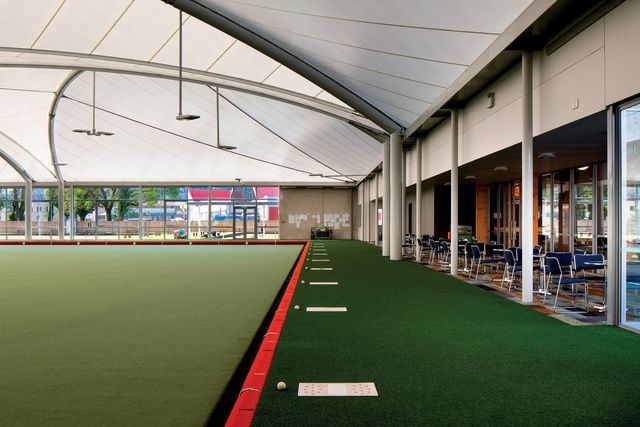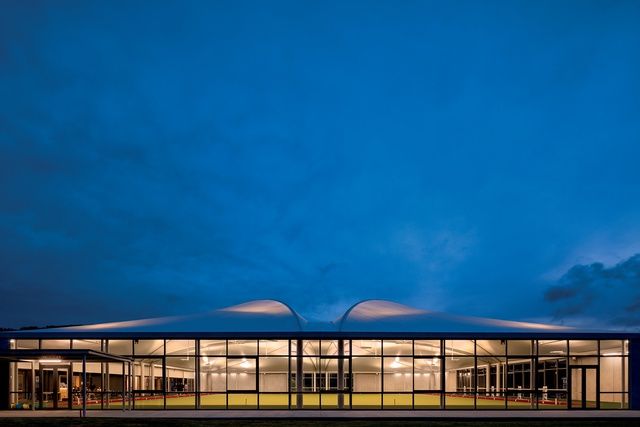‘A mammoth effort’: Naenae Bowling Club



The sport of bowling has had somewhat of a renaissance in the past decade. Younger people and families are increasingly frequenting their local bowling clubs for the not-too-strenuous and sociable sporting activities (bowls, pool and darts) and, of course, the cheap beer and food.
In Lower Hutt, Naenae Bowling Club (NBC) has created a progressive new regional bowling facility that’s not only equipped to serve the local community but designed to entice international-quality sportspeople to the venue and, inevitably, spend money in the area as well.
In April, this new all-weather venue hosted the $100,000-prize-winning Bowls Premier League (#BPL07) – the bowling equivalent to cricket’s Indian Premier League – a tournament that drew seven teams from around Australia, including the Sydney Lions and the Silkari Illawarra Gorillas, to be pitted against the New Zealand Blackjacks. Ten medal-winning athletes from the 2018 Commonwealth Games, including five gold medallists, played in the tournament and it was broadcast live online and via Sky Sports.

The bar and spectator areas overlook the Super Turf-clad bowling rink. Image: Jason Mann.
Architect Ewan Brown of Tennent Brown Architects, which designed the new NBC, and his client Peter Healy, general manager at Community Facilities Trust (CFT) – the development arm of Hutt City Council – proudly explain that membership has grown from around 200 to nearly 900 since the new building opened in September last year. “The membership is far more than we expected and NBC is now the largest club in the country,” says Healy. “Mark Cameron, the CEO at Bowls New Zealand, said it was the best bowling club in the country by a long shot.
Healy explains that what was an amateur club has now turned into a fairly large operation so they’ve had to appoint full-time managers and a lot more staff. “It’s created jobs but it’ll take a little while to become profitable,” he adds. We had said to Council that we wouldn’t just generate good social activity but good economic activity as well.
That was shown when we had the large bowling competition; the club was packed with people. It was quite spectacular and the local motels were filled up. The Aussies said it was the best place they’d played in and that they’d come back again, although they did complain that they wanted us to put in some heaters!”
The new facility is the result of the merger of two bowling clubs in Lower Hutt. The CFT sold valuable land beside Boulcott Hospital (a private facility adjacent to Hutt Hospital) to help fund the new amalgamated NBC.
“The reason that the design was of this standard was so we could move one bowling club from a pretty attractive end of town to what was a derelict site here,” explains Healy. “But now we can also expand the hospitals, which together are buying the land. That process is under way but there is still a lot of paperwork to get through.”
The NBC site is located bang in the middle of a mixed-use area; there is an industrial zone on the opposite side of Vogel Street. Behind, is a state housing zone, which runs along Treadwell Street and, adjacent, are various sporting amenities, including an Olympic-sized swimming pool and tennis courts.
“There was an existing bowling club building on the site, which had an asbestos roof and fill under the slab, as well as a derelict car-parking area,” explains Brown. The architects also refurbished the tennis courts, inserted swales into the car park, rebuilt the club rooms, added an indoor bowling rink, refurbished three outdoor greens and added new petanque courts. Wraight & Associates landscaped its surrounds, including an area, sited near the main entrance of the building, which is set aside for Anzac Day ceremonies.
However, the club’s most spectacular feature is its 50m x 50m indoor room containing the bowling rink, enclosed by an innovative roof, which was initially based on a xanadome-type system but cleverly redesigned by engineers Dunning Thornton for the task. “The structure had to be long span because you can’t put a post down in the middle of the bowling green so we needed to decide how to span this distance,” says Brown.
“If we did a very heavy roof, then it would have turned into a very big structure with big beams and a boxy shape – so we realised that a xanadome-type roof was the way to do it; we didn’t need an indoor thermal environment. This space is essentially outdoors so you can feel the temperature difference; it’s more outside than inside.”
Brown was initially concerned that the space might overheat during the summer months and that condensation might appear in the corners during the winter. However, the services engineer said it would be okay and it has proven to work well, thanks to big sliding windows that create-cross ventilation.
“When we first put the fabric roof up, we had some condensation because it was really cold outside,” explains Brown. “The room had been locked up and it was humid because water was coming out of the ground but I think we have an equilibrium now – so it’s been an interesting process.”
Raising the roof structure was a mammoth effort. “It looked like half of Wellington’s scaffolding was in this room,” jests Brown. “They had to hold the structure up and make some blocks that sat in two places. They put it in one place to start with and, then, when the fabric went on, they had to drop it to ease it together to gain the balance of the structures.
“Then, there is something like a six-tonne piece of steel in the middle and there’s a hole with a little cap over it, because, when you look at the geometry, there are several arches of fabric, which would flatten the middle. So, we had to do something to stop the water from bombing. This central steel element holds all the steel tension structures together and it also spreads the loads; a little dome over it lets air out and ensures that rainwater rolls off.”
Another interesting feature are the stalks of LED lights that hang down from the roof structure, providing an even light down into the space for the bowlers. At night, the whole roof lights up and glows.
Peter Healy says that this $6.25-million project is the fifth building the CFT has built since 2012. “At a total value of around $50 million, these investments have begun to transform the whole neighbourhood. It used to be a derelict area and we’d have hundreds of graffiti events every few months but that’s all died away.
“Hutt City Council’s social arm has put a lot of horsepower into the neighbourhood too; they moved staff into the swimming pool facility next door to engage with the community so they understand what’s happening. A lot of investment goes in and around our developments, and we were determined that this wasn’t just a bowling club but a community centre too.
“At the community end of the building, you can come in for a coffee and a scone and engage at that level. The young mums can come in and do yoga, then, down a bit, there’s the RSA sector with their darts and pool, then, along further, there are gaming machines, then, there’s the bar and then the bowls – so it transitions.”

A north-facing night-time view of the indoor bowling rink glowing in the dark. Image: Jason Mann.
The NBC adds yet another layer to the fascinating social and architectural history of the area. “Naenae, Taitā and those other suburbs running through Lower Hutt were First Labour Government state housing developments,” explains Bill McKay, co-author of Beyond the State: New Zealand State Houses from Modest to Modern.
“They ran a train up there, too, so that was early recognition of the importance of public transport. Ernst Plischke designed the Naenae town centre, which was based on St Mark’s Square in Venice, although his town square and community centre never happened. However, Naenae did gain the first pedestrian plaza in the country, called Hillary Court after Sir Edmund Hillary.
“Plischke had other radical ideas, such as being able to have cups of coffee at tables and chairs on the footpath but that was also a bit too radical for the time. There were a number of modernist gems in Naenae too, such as the Post Office by Gordon Wilson, and there was also a big focus on building community facilities. So, it wasn’t just a sprawl of state houses, it was about having a community heart.”
The NBC ensures that community spirit continues to flourish in Naenae, with the added bonus that the architecture is also celebrated.
This article was originally published on ArchitectureNow




 Indonesia
Indonesia
 New Zealand
New Zealand
 Philippines
Philippines
 Hongkong
Hongkong
 Singapore
Singapore
 Malaysia
Malaysia








